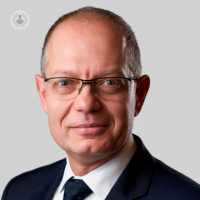A guide to arteriovenous malformations (AVM)
Written by:Normally present at birth, AVMs cause around 2% of haemorrhagic strokes every year. Mr Christos Tolias, leading neurosurgeon and expert in AVMs, explains more about the condition.

What is an arteriovenous malformation?
Normally, blood flows from the heart to the arteries of the body. The arteries branch and get smaller until they become a capillary, which is just a single cell thick. In this way blood pressure drops to very low levels that the thinner walled veins can cope with. In an AVM, usually early in life, arteries connect directly to veins. This is a high-pressure shunt or fistula. Veins are not able to handle the pressure of the blood coming directly from the arteries. The veins stretch and enlarge and create what we call a ‘nidus’. Usually, there are multiple feeding vessels in an AVM and many draining veins.
Apart from the typical AVM described above there are other ‘vessel abnormalities’ routinely seen in scans of the brain (venous malformation – abnormal cluster of enlarged veins resembling the spokes of a wheel with no feeding arteries; low pressure, rarely bleed and usually not treated and capillary telangiectasia – abnormal capillaries with enlarged areas; very low pressure and usually not treated either). Brain AVMs can occur on the surface (also called cortical), deep (in the thalamus, basal ganglia, or brainstem), and within the dura (the tough protective covering of the brain). Spinal AVMs can occur on the surface (extramedullary) or within the spinal cord (intramedullary).
Learn more about cavernomas - a type of arteriovascular malformation
What are the symptoms?
The symptoms of AVMs vary depending on their type and location. While migraine-like headaches and seizures are general symptoms, most AVMs do not show symptoms (asymptomatic) until a bleed occurs. Common signs of brain AVMs are:
- Sudden onset of a severe headache, vomiting, stiff neck
- Seizures
- Migraine-like headaches
- Swelling or redness of an eye with a particular type of dural AVM called a carotid-cavernous fistula or ‘CCF’
- Noise in the head, called a ‘bruit’. A dural AVM can cause a bruit due to the blood flowing through it
AVMs can damage the brain or spinal cord in three basic ways:
1. AVMs can rupture and bleed into the brain—called an intracerebral haemorrhage (ICH), or they can bleed into the space between the brain and skull — called a subarachnoid haemorrhage (SAH). Bleeding is the most serious complication of a vascular malformation, because of the risk of brain damage
and so it is treated as an emergency. Sometimes a bleed may be small and produce no symptoms at all.
2. AVMs can exert pressure against the surrounding brain, resulting in seizures or hydrocephalus.
3. AVMs can very rarely reduce the amount of oxygen delivered to nearby tissues and cause neurological symptoms.
Risk of bleeding
The risk of AVM bleeding is 2 to 3% per year. Death from the first haemorrhage is between 10 to 15%. Once a haemorrhage has occurred, the AVM is more likely to bleed again during the first year (6%). Lifetime risk is more difficult to calculate in particular for incidental, non ruptured AVMs. For example, a 25-year-old man has an 80% lifetime risk of bleeding (at least once). Many factors affect this percentage, including where the AVM is located and what type of AVM it is. It’s best to talk to your doctor about your own individual risk.
Who is affected?
AVMs of the brain and spine are congenital (present at birth) and are relatively rare. They affect both men and women at about the same rate. AVMs account for about 2% of all haemorrhagic strokes each year.
To find out more about Mr Tolias and the London Neurosurgery Partnership click here


